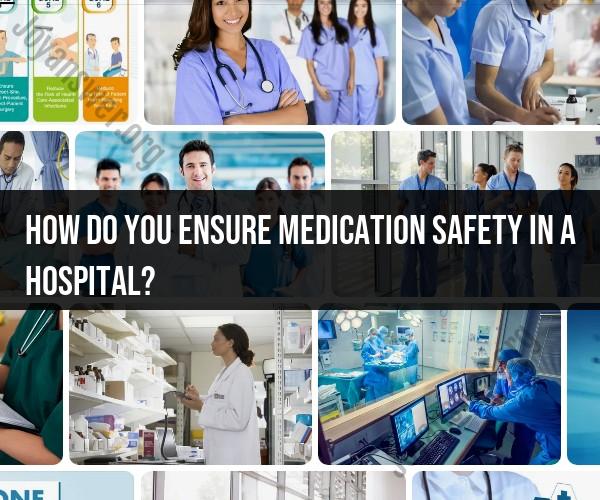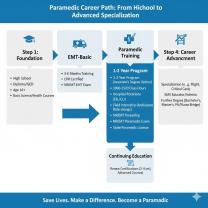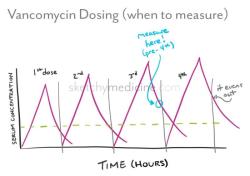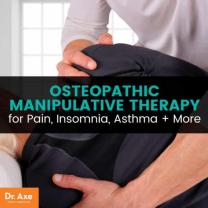How do you ensure medication safety in a hospital?
Ensuring medication safety in hospitals is a critical aspect of patient care, as medication errors can lead to serious harm or even fatalities. To prevent medication errors and promote safe medication practices, hospitals implement various best practices. Here are some key strategies and guidelines for ensuring medication safety in a hospital setting:
Barcoding and Scanning Systems:
- Implement barcode scanning systems for medication administration. This helps ensure that the right patient receives the right medication in the right dose at the right time.
Electronic Health Records (EHRs):
- Utilize electronic health records to document medication orders, administer medications, and check for allergies, interactions, and duplicate therapies.
Medication Reconciliation:
- Perform medication reconciliation upon admission, transfer, and discharge to ensure that patients are on the correct medications and dosages. Include a comprehensive medication history review.
Standardized Medication Order Sets:
- Use standardized order sets and protocols for common conditions to reduce variations in medication orders and improve adherence to best practices.
Double-Check Procedures:
- Implement double-check procedures, especially for high-risk medications. Two healthcare professionals should independently verify medication orders and administration.
High-Alert Medications:
- Recognize and prioritize high-alert medications, such as opioids, insulin, and anticoagulants, and apply additional safety measures for their administration and monitoring.
Medication Education and Training:
- Ensure that healthcare professionals are well-trained in medication administration, including dosage calculations, drug administration routes, and recognizing potential side effects and adverse reactions.
Patient and Family Education:
- Educate patients and their families about their medications, including names, purposes, dosages, administration routes, and potential side effects. Encourage patients to ask questions and express concerns.
Use of Tall Man Letters:
- Use tall man letters (e.g., HYDROmorphone vs. HYDROcodone) to differentiate look-alike and sound-alike medications, reducing the risk of confusion.
Labeling and Packaging:
- Ensure that medications are clearly labeled with the patient's name, medication name, dose, and administration instructions. Store and package medications in a manner that minimizes confusion.
Pharmacist Involvement:
- Involve pharmacists in medication management to review orders, assess drug interactions, provide medication counseling, and collaborate with healthcare teams.
Independent Verification:
- Implement independent verification for high-risk processes, such as the preparation of intravenous (IV) medications, to minimize errors.
Automated Dispensing Systems:
- Use automated dispensing systems to store and dispense medications, allowing for controlled access, tracking, and auditing of medication distribution.
Quality Improvement and Reporting:
- Establish a culture of continuous quality improvement and encourage reporting of medication errors and near misses. Analyze these incidents to identify root causes and implement preventive measures.
Drug Information Resources:
- Provide healthcare professionals with easy access to drug information resources, such as drug handbooks and databases, to support informed decision-making.
Patient Identification:
- Verify patient identity using at least two unique identifiers (e.g., name and date of birth) before administering medication.
Closed-Loop Medication Systems:
- Implement closed-loop medication systems, where the entire medication process, from order entry to administration, is tracked and verified electronically.
Regular Auditing and Monitoring:
- Conduct regular audits and monitoring of medication safety practices to identify areas for improvement and ensure ongoing compliance.
By implementing these best practices and maintaining a strong culture of safety, hospitals can significantly reduce the risk of medication errors and enhance patient outcomes. Patient safety is a shared responsibility among all healthcare professionals, and a collaborative approach is essential to ensuring medication safety in hospital settings.
Ensuring Medication Safety in a Hospital Setting
Medication safety is a top priority in all healthcare settings, but it is especially important in hospitals, where patients are often taking multiple medications and may be more vulnerable to medication errors. There are a number of things that hospitals can do to ensure medication safety, including:
- Implementing medication safety systems and processes. This includes things like computerized prescriber order entry (CPOE), barcode medication administration (BCMA), and independent double checks.
- Educating healthcare professionals about medication safety. This includes training on how to prescribe, dispense, and administer medications safely.
- Creating a culture of medication safety. This means empowering healthcare professionals to report medication errors and to work together to prevent them from happening in the first place.
Best Practices for Medication Safety in Healthcare
Some of the best practices for medication safety in healthcare include:
- Use clear and concise medication orders. This helps to reduce the risk of misinterpreting orders.
- Use CPOE to electronically enter medication orders. CPOE can help to identify potential drug interactions and allergies.
- Use BCMA to scan barcodes on medications and patients' wrists before administering medications. This helps to ensure that the right medication is given to the right patient at the right time.
- Perform independent double checks before administering medications. This helps to catch any errors that may have occurred earlier in the medication process.
- Educate patients and caregivers about their medications. This includes teaching them about the purpose of each medication, how to take it correctly, and what to do if they have any side effects.
The Role of Healthcare Professionals in Medication Safety
All healthcare professionals play a role in medication safety. This includes physicians, nurses, pharmacists, and other healthcare workers. Here are some specific things that healthcare professionals can do to promote medication safety:
- Be familiar with the medications that they are prescribing, dispensing, and administering. This includes knowing the potential side effects and interactions of each medication.
- Follow medication safety procedures. This includes things like using CPOE and BCMA, and performing independent double checks.
- Report medication errors immediately. This helps to identify and address potential problems in the medication process.
Building a Culture of Medication Safety in Hospitals
Building a culture of medication safety in hospitals requires the commitment of everyone in the organization, from the CEO to the frontline staff. Here are some things that hospitals can do to build a culture of medication safety:
- Create a safe environment for reporting medication errors. This means that healthcare professionals should not be afraid to report medication errors without fear of retaliation.
- Use medication errors as opportunities for learning. When a medication error occurs, hospital leaders should work with staff to identify the root cause of the error and to develop strategies to prevent it from happening again.
- Recognize and reward healthcare professionals for their efforts to promote medication safety. This helps to send the message that medication safety is a top priority.
Strategies for Preventing Medication Errors in Hospitals
There are a number of strategies that hospitals can use to prevent medication errors. Some of the most effective strategies include:
- Implement medication safety systems and processes. This includes things like CPOE, BCMA, and independent double checks.
- Educate healthcare professionals about medication safety. This includes training on how to prescribe, dispense, and administer medications safely.
- Create a culture of medication safety. This means empowering healthcare professionals to report medication errors and to work together to prevent them from happening in the first place.
By implementing these strategies, hospitals can help to ensure that patients receive the right medications at the right time in the right dose.













